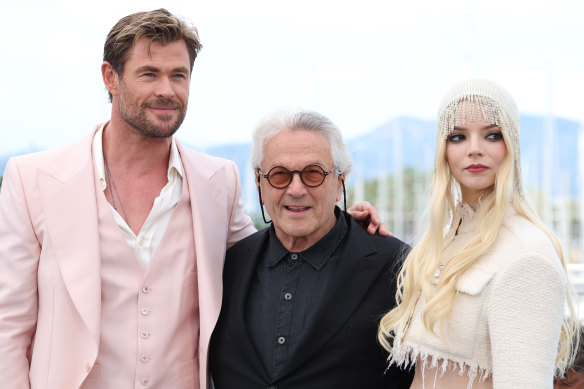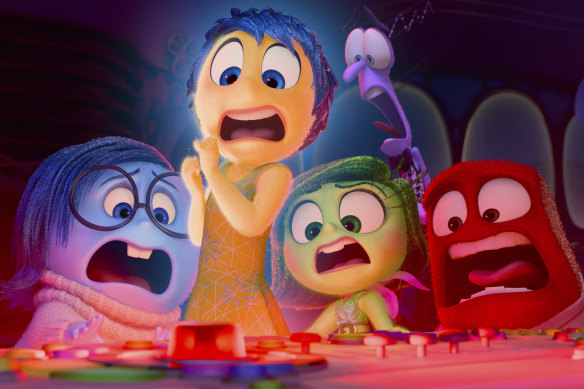
When George Miller’s $400 million desert epic Furiosa: A Mad Max Saga opened with a thud last month, the prognosticators were out in force. The era of the blockbuster was finally over. Cinema was dead. Hollywood had finally proven “nobody knows anything” was more than an ironically uttered maxim in the business, it was fact.
Notwithstanding the fact Mad Max films have tended to open slowly before going on to enjoy a long life, there are objective reasons why anyone who loves seeing movies on a big screen should be a little concerned. The Australian box office is down 12.8 per cent year-on-year. In the US, it’s even worse, down more than a quarter (by just over $US1 billion) compared to the same time in 2023.
Compared to pre-COVID times, the decline is even more pronounced. A leading industry analyst recently predicted global box office will max out at $US32.3 billion this year. In 2019, the global haul was a record $US42.3 billion.
Four years after COVID threw the cinema business under a bus it is barely three-quarters of the way back to recovery.
The movie business is, of course, notoriously cyclical, and a year can be made or broken by a handful of films. But some seasoned observers are now starting to wonder if the decline is more structural, and reflects the fundamentally different nature of how audiences are watching.

Director George Miller, centre, with stars Chris Hemsworth and Anya Taylor-Joy launched Furiosa: A Mad Max Saga at Cannes in mid-May. By the end of the month it had been declared a box office flop.Credit: Pascal Le Segretain/Getty Images
Speaking on the podcast The Town after the holiday weekend on which Furiosa opened, veteran showbiz journalist and former news editor of The Hollywood Reporter Matt Belloni labelled it the “Memorial Day massacre”. “If you adjust for inflation and exclude [pandemic year] 2020 this would be the worst Memorial Day weekend result for the top movie in 43 years … the bottom line is the box office is in real trouble right now”.
Months earlier, Belloni’s old outlet had cast the situation facing the film business as “an existential crisis”.
“One out of every five moviegoers has vanished since the pandemic, according to research compiled by one Hollywood studio,” The Hollywood Reporter claimed in January. “Whether they’ll ever return to see a film on the big screen is anyone’s guess – and, if they do, when.”
Things are grim right now. But does this dire state of affairs mean we are witnessing the beginning of the end of cinema?
Absolutely not, says Mike Baard, Australian chief of Universal Pictures, the largest distributor of motion pictures in the country.

Pixar’s Inside Out 2 is one of the big releases on a slate that has been sadly lacking in them. Credit: AP
“I don’t think there’s anything wrong with the fundamentals,” he says. “As somebody who’s been in this business a long time, I’m as confident as I could be that we’ll have a really fantastic run ahead. But there’s no question that this calendar year is going to be challenged. There’s just not enough big movies on the slate.”
The two COVID-affected years, followed by last year’s Hollywood strikes, have, says Baard, “thinned out the release slate quite considerably”.
“It is damn difficult right now,” concurs Benjamin Zeccola, chief executive of independent exhibitor and distributor Palace. “But as far as I’m concerned, we’ve bridged the hardest part, and now it’s time to build up again. We’ve got Inside Out 2, the new Minions movie (Despicable Me 4), Yorgos Lanthimos’s Kinds Of Kindness, Fly Me to The Moon, the Midnight Oil movie, foreign films, and the release chart just gets busier from here. Survive til ’25, I say – and then thrive in ’25!”
At least one studio appears to believe there is plenty of life left in the cinema business. Sony Pictures this week acquired the 35-theatre Alamo Drafthouse Cinema chain in the US. In doing so, it effectively wound the clock back to 1948, when anti-trust legislation forced the studios to divest their theatre businesses. That legislation was rescinded in 2020, but until now only Amazon and Netflix had taken ownership of cinemas, in a move widely interpreted as a ploy to allow their films to qualify for Oscar contention.
There was evidence in mid-2022 that audiences were finally willing to get past their reluctance to enter an enclosed, crowded space, as Top Gun: Maverick soared to just shy of $US1.5 billion worldwide. The combined might of Barbenheimer last year supported the argument that for the right films, people would still flock to the cinema. Industry figures are keen to point out that four of the six highest-grossing movies in Australia have been released since the pandemic.
But that owes something to the fact going to the movies has become a premium experience, with premium(-ish) prices. Australian cinemas are among the best in the world, with the best of them offering comfortable and generous seating, excellent sound and image quality and in-theatre dining and drinking. The reality is attendances have yet to return to anything like pre-COVID levels. In 2019, Australians bought 84.7 million movie tickets. In 2022, they went 57.9 million times. Last year the number was 58.1 million.

Palace Cinemas CEO Benjamin Zeccola.Credit: Jason South
“Has the habit been broken? Yes, it has,” concedes Baard. “You’ve had a global pandemic, and concurrent with that the rise of streaming … so it’s not a surprise audience habits have shifted. There’s no question audiences recognise that cinema is the most impactful and immersive place to see a movie. But that doesn’t mean they are willing to go and see every movie in a cinema.”
If he’s correct that the right films will still get people going to the cinema, what even constitutes the right film? A quirky memoir piece about a 70-year-old man with a dodgy knee walking 700 kilometres in Spain? Surely not. And yet Bill Bennett’s The Way, My Way has been one of the local surprises of the year, taking over $1 million in three weeks after a relatively small rollout by a tiny independent distributor. True, it wouldn’t get the accountants at a Hollywood major too excited, but it does indicate that a film that knows, speaks to, and connects with its audience can still get bums on seats.
On the other hand, Hit Man, from renowned auteur Richard Linklater (Boyhood, School of Rock, the Before trilogy), bypassed cinemas entirely after Netflix snapped it up at the Venice Film Festival last September for $US20 million.
Speaking to the BBC recently, Linklater claimed he and co-writer and star Glenn Powell couldn’t even find a studio willing to promote and distribute their movie. “Netflix was always passionate about it, but the others kinda weren’t,” he said. “I think they weren’t sure if they could sell it to an audience.”
The Netflix deal comes with guaranteed profit (reports suggest the film cost about $US10 million to make), something that could not be said had it gone to cinemas once the marketing and distribution costs – likely two to three times its budget – are factored in. But while the deal takes risk out of the equation, it also eliminates potential reward. And given the movie was watched 10.8 million times in its first week on the streamer, the “blue sky” could have been enormous.

Actor Laura Lakshmi and pilgrims Balazs Orban and Laszlo Vas, in Bill Bennett’s surprise micro-hit The Way, My Way.Credit: Maslow Entertainment
One veteran filmmaker who spoke on the condition of anonymity in order to offer insight into how a movie makes money says the focus on box office alone is shortsighted. “Theatrical is just a part of what we call the revenue waterfall,” the filmmaker says.
The filmmaker’s insights were endorsed by two senior executives in the industry with thorough knowledge of so-called waterfalls.
The precise split of revenues will vary depending on the initial box office performance, the profile of the film, and its genre (horror, for instance, generally does better theatrically than at home).
First comes the theatrical release, which is both the highest-profile moment in a film’s life cycle and the most costly because so much money is spent to capture an audience’s attention, and to try to convince them of the urgency of seeing the film in a cinema right now. On a reasonably successful release, this might account for around 35 per cent of revenue over the life cycle of the film. But as even the streamers have begun to concede (with the exception of Netflix), the theatrical release is vital in raising awareness and setting up the rest of the film’s revenue journey.
Next comes the home entertainment window. As late as 2015, this opened 128 days after theatrical debut. Now it is typically 42 days (six weeks), and in some instances as little as 17 days. Physical formats (DVD and Blu-Ray) still play a role here, but increasingly it is digital distribution via Premium Video on Demand (PVOD) for around $30-$35. Furiosa is expected to do particularly well in this space.
Then comes the next tier, about three months after cinema release, when a film can be bought digitally for around $20 or rented for about $7. The combination of PVOD, TVOD and physical formats is worth about 25 per cent of the total.
Next comes the P1 (first pay) window, when the title will appear on a subscription video-on-demand service such as Netflix or Stan – usually exclusively, rarely on more than two – for around 12 months. This could be worth 15-20 per cent of the total. Then comes P2, where it goes to other services (10 per cent). At the same time, and assuming it is a high-profile title, the film will have been sold to a free-to-air network (10 per cent).
Towards the end of the journey, the film will enter the re-licensing phase, where it is picked up again, typically on a 12-month contract, by any number of platforms. There’s also the various smaller ancillary deals encompassing airlines, hotels and other outlets.
The entire life cycle will, the filmmaker says, typically last three to four years, though some films can continue to enjoy a life well beyond that.
The film business, with its fixation on weekend grosses, has only itself to blame for the focus on box office at the expense of everything else. But in truth, it’s just a small part of a much more complicated picture.
Contact the author at kquinn@theage.com.au, follow him on Facebook at karlquinnjournalist and Twitter at @karlkwin, and read more of his work here.
Find out the next TV, streaming series and movies to add to your must-sees. Get The Watchlist delivered every Thursday.



























